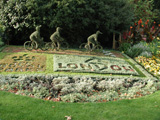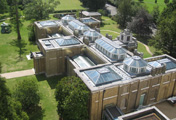A Visual Documentary of Queen Elizabeth II’s Sixty years on the Throne
Originally published in July 2012 in American in Britain Magazine
The National Portrait Gallery exhibition, ‘The Queen: Art & Image’, documents the way in which Queen Elizabeth II has been portrayed through the six decades of her historic reign. The exhibit aims to present a progressive dialogue between traditional portraits and a multiplicity of media images. It brings together a variety of royal representations including formal portraiture, official photographs, media pictures and several unconventional responses by contemporary artists.
A Visual Documentary of Queen Elizabeth II’s Sixty years on the Throne
The National Portrait Gallery exhibition, ‘The Queen: Art & Image’, documents the way in which Queen Elizabeth II has been portrayed through the six decades of her historic reign. The exhibit aims to present a progressive dialogue between traditional portraits and a multiplicity of media images. It brings together a variety of royal representations including formal portraiture, official photographs, media pictures and several unconventional responses by contemporary artists. Material is drawn from newspapers, film, television and postage stamps; it is often satirical. This multi-textured survey highlights significant historical moments in the life of the monarch, her family and the nation. Now, in the year of the Queen’s Diamond Jubilee, the public is invited to see this unique visual documentary of Elizabeth II’s sixty years as Queen.
The exhibition begins in the 1950s when, upon the death of her father, King George VI in 1952, Princess Elizabeth ascended the British and Commonwealth throne. The sad occasion of his death is expressed in a black and white photograph of young Princess Elizabeth, Queen Mary and the Queen Mother at Westminster Hall during her father’s lying in state. The following year saw Queen Elizabeth elevated to the highest position in the land, an event captured by Cecil Beaton, Court photographer to the British Royal family. Beaton recorded the momentous occasion of the Coronation in Westminster Abbey in June 1953. His iconic photograph of the Coronation is placed next to a video installation of the Coronation in the first room of the exhibition. Beaton’s long relationship as royal photographer from the 1940s to the 1960s has left a rich legacy and several of his photos are included. Especially moving are the photographs of a young contemplative Princess Elizabeth taken in 1948- just twenty-two years of age. Beaton also captured many important moments in the lives of the royals such as his images of the Queen as a mother shown her with young children. His special gift was the ability to capture the formality of royal occasions and situations where the Queen is shown in more informal settings.
When Elizabeth II ascended the throne in 1952, Britain still had an empire. Although pretentions of the Victorian age in Britain were on the wane, historians have described this period as one which is characterised as the ‘de-Victorianisation’ and downsizing of the British Empire. (1) Still, in the 1950s traditions and formality were firmly in place and representations of the monarch were carefully orchestrated. A good example is the photograph of Queen Elizabeth II by Dorothy Wilding taken in 1952. (pictured) The catalogue informs us that “Dorothy Wilding first photographed the Queen in 1937 at the Coronation of her father, King George VI. To mark her accession, Elizabeth posed for the photographer fifty-nine times, wearing gowns by Norman Hartnell.”(1) How very carefully staged this image is.
In keeping with the tradition of great royal portraiture there are two remarkable paintings of the Queen, both by Pietro Annigoni. His first, Queen Elizabeth II, Queen Regent (1954-55) is a full-length portrait in tempera, oil and ink on paper on canvas.(pictured) Annigoni’s second portrait,1969, is shown on the same wall. Described in the catalogue: “the 1969 portrait was Commissioned by the National Portrait Gallery,[and] was unveiled in 1970 to enormous public and press interest. Reaction focused on the contrast with Annigoni’s earlier portrait, which presented a romantic, idealised view. The new portrait adopted a radically different approach. The artist explained: ‘I did not want to paint her as a film star; I saw her as a monarch, alone in the problems of her responsibility.”(Catalogue p90)’
While the Coronation service was the first major international television broadcast, it wasn’t long before the Queen made herself available to the media. She broadcast her first Christmas message to the nation live on the radio in 1952. Only a few years later, 1957, she gave her first televised black and white Christmas broadcast (pictured). And in 1967 she broadcast her Christmas message in colour, now an annual event. But television and media exposure was becoming more intrusive. The nation wanted to know who the Queen was. And what about her family? In 1969 the documentary Royal Family was broadcast twice in June and nearly 70% of the British population viewed Cawston’s film. It radically changed the public perception of royalty. Cameras were admitted for the first time behind the scenes and viewers saw the Queen speaking informally in private situations. Less of a remote icon, she emerged as an individual. Henceforth it was the media in all its form which came was to influence the way she and her family would be represented in the future.
Throughout the decades 70s and 80s Queen Elizabeth’s iconic global celebrity came in for both gentle and harsh representation. In the 70s gallery you will find an informal photo of the Queen and Prince Philip on board the Royal Yacht Britannia deeply concentrating on her ‘boxes’ containing documents for attention and signature. The press captured her in many informal settings –some with politically sympathetic overtones such as her visit to the Silverwood Colliery, Rotherham in July 1975. Others, however, were more subversive such as the God Save the Queen poster image by Jamie Reid in 1977. Deference toward the royals had been on the decline for a long time and this poster was regarded as visual assault in a social climate less inclined to deference. It was banned by the BBC.
These six decades have marked turning points in representations of the Queen. David Cannadine’s catalogue essay provides a clear focus for analysing how images of monarchy were portrayed and evolved. He writes: “To a greater or lesser degree, every visual representation conveys information not only about its subject, but also about the circumstances of its making. From the values and intentions of its creator to the social conditions that determined its particular appearance – as the adage informs us: every picture tells a story”. Thus it can be argued that images of the Queen have continuously negotiated a balance between her historic role as the constitutional monarch and that of a woman who inhabits the role while maintaining a relationship with society. It has not been easy to maintain the balance. Further, as Cannadine point out: “Today, and in a manner that had not been true during the reign of any previous sovereign, Britain is a multicultural, multi-ethnic, multi-faith society, where social inclusion is the conventional wisdom and aspiration….”(1))
In the 80s images of the Queen were appropriated by artists such as Andy Warhol whose fascination with fame knew no boundaries. Several of his screen prints transformed the features of Queen Elizabeth and are featured in the exhibition alongside works by Gilbert and George. The 90s includes artists’ various portraits and pictured here is ‘The Queen’ by Justin Mortimer, 1998, was based on drawings made from life and photographs. Here is a distinctly modern representation depicting the Queen in flattened, cut-out shapes that appear to separate her head from her body. The millennium saw further works by some of Britain’s most eminent artists. And in 2001 Lucian Freud’s controversial portraits was the product of several sittings in St James’s Palace between May 2000 and September 2001. When compared to Dorothy Wilding’s image some fifty years earlier, we see how Freud painted the Queen emphasising age and experience.
Unique among the varied representations of Queen Elizabeth is Hew Locke’s unconventional ‘Medusa’, 2008.(pictured) This mixed media collage consists of plastic lizards and beads, among other throw-way objects. Here is a portrait that is both humorous and full of tension. Locke’s portrait stands alone in a cubicle-like space in the gallery. Born in Edinburgh in 1959, Locke grew up in British Guyana and the idea of Britishness is a central theme in his work. His ‘Medusa’ is at once traditional and subversive. It is on loan from the Arts Council Collection. Take time to gaze at Locke’s ‘Medusa’-Queen. You may feel it exudes an almost devotional feeling – or perhaps not. Every picture tells a story.
In 2011 the National Portrait Gallery commissioned the German photographer Thomas Struth to make a large-scale portrait photograph of the Queen and The Duke of Edinburgh to mark the Queen’s Diamond Jubilee and the Duke’s ninetieth birthday. The photograph is shown for the first time in the National Portrait Gallery. The Queen and the Duke are seated together in the Green Drawing Room at Windsor Castle. This photo of the Queen and Duke brings the royal couple up to date and is an appropriate coda to an extraordinary assembly of images in ‘Queen: Art &and Image’. Although as Americans we do not have the tradition of an unelected Head of State – surely it is remarkable to have had one extraordinary woman on the British throne for sixty years. The exhibition continues until 21st October 2012.
References:
The Queen Art & Image. Catalogue. National Portrait Gallery Copyright © 2011
1. Cannadine, D. Sixty Years a Queen. Catalogue essay: The Queen Art & Image. Copyright © 2011 p.24
2. Cannadine, D. ibid. pp-21-22
3. Paul Moorhouse. Catalogue essay: The Queen Art & Image. National Portrait Gallery © 2011. p.57
©Abby Cronin



